Southwest Michigan field crops update – April 28, 2022
Although temperatures remain unseasonably cool, drier conditions have allowed a surge of fieldwork on lighter soils as planting season 2022 commences.

Weather
Temperatures this past week were normal in the region…sort of. With temperatures well above normal over the weekend and below normal otherwise, the average was normal for this time of year. A Canadian-origin air mass over the Great Lakes region has brought below freezing temperatures for essentially the entire state—unusual for this time of year. There is another threat of frost Friday morning, but temperatures will moderate heading into the weekend as the high pressure system moves to the east and highs will remain in the low- to mid-60s for most of the coming week. However, all of the mid- to long-range outlooks, including the one-month outlook for May, predict below-normal temperatures for southern Michigan.
Soil temperatures dropped as air temperatures cooled down after last weekend as expected, but they remain warm enough for planting with a reasonable expectation of emergence within two weeks. Air temperatures during the forecasted rain events in the coming week will be mostly in the 50s, so risk of injury from imbibitional chilling should be low. With daily highs forecasted to be in the mid-50s to mid-60s and lows staying above 40 degrees Fahrenheit, soil temperatures should remain in decent shape as planting ramps up.
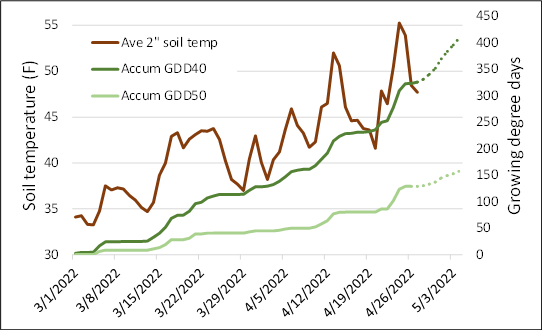
Precipitation this past week ranged from 0.5 to 3.0 inches in the region with a north-south gradient. Those totals ranged from 50% below normal to 50% above for most areas, although rainfall was over three times the normal amount for this time of year closer to Grand Rapids, Michigan. Soil moisture remains high throughout most of southern Lower Michigan. Side note: Soil moisture in the wheat growing regions of the Great Plains remains extremely low, and with most of that region in D2-D4 drought, the wheat crop may be severely impacted this year. The forecast for the coming week calls for 0.75-1.0 inches of rain, most of that falling Saturday night and next Tuesday. The mid-range outlooks call for a slight chance of wetter than normal conditions for the first week of May followed by drier than normal heading into the second week.

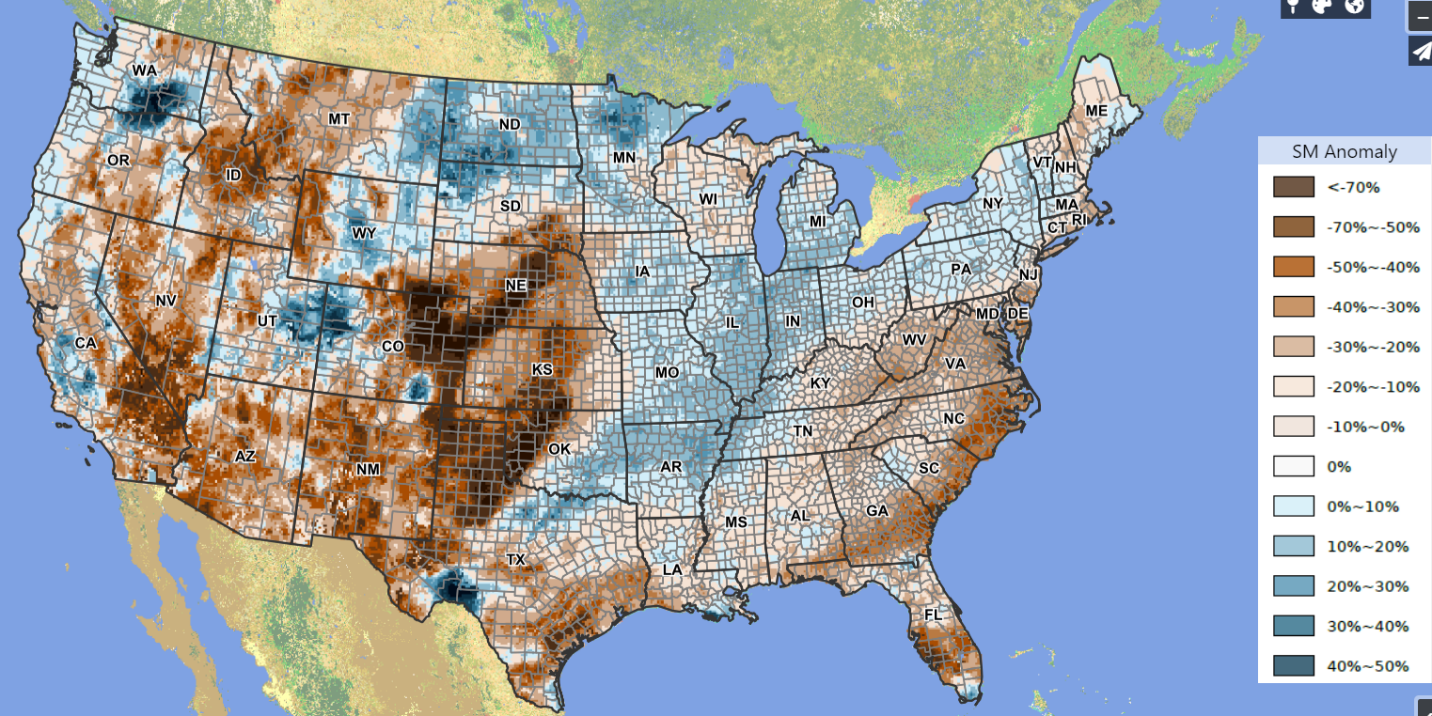
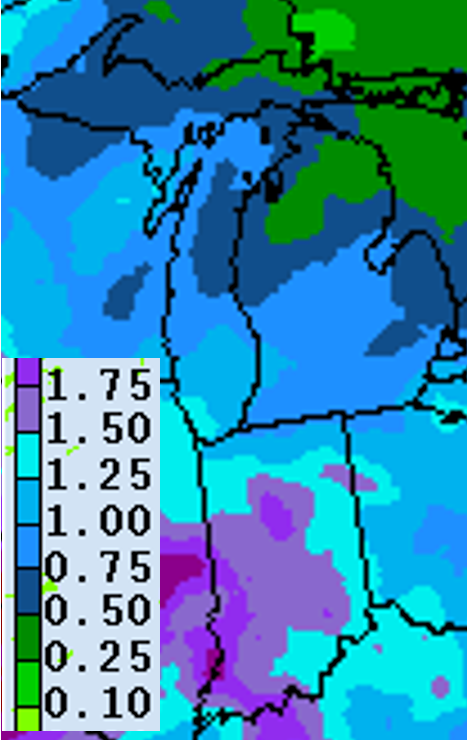
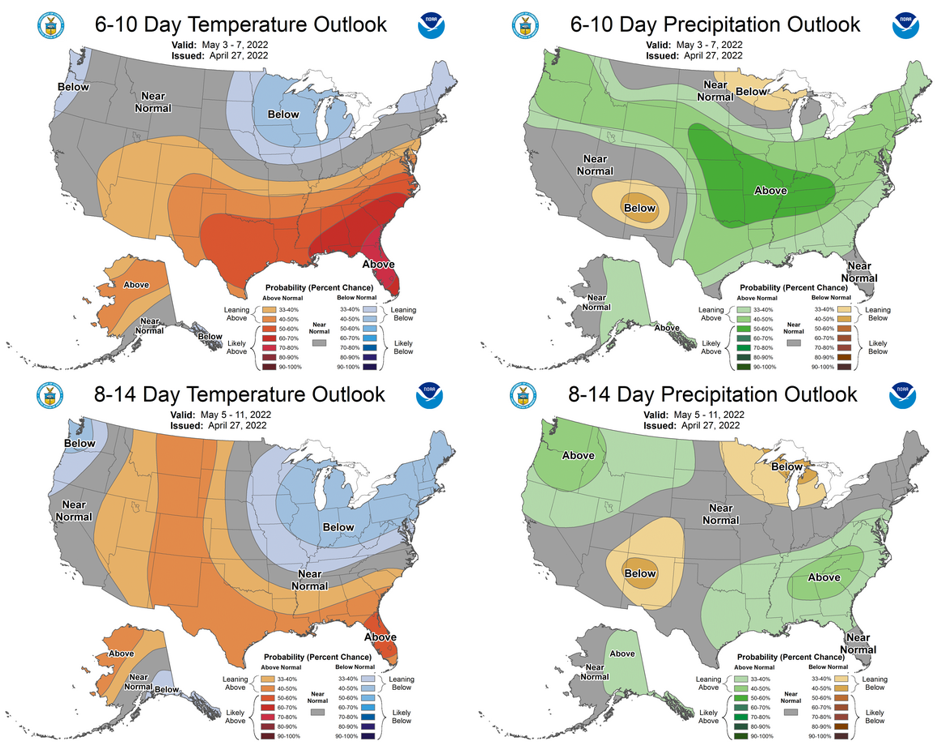
Crops and pests
Potato planting has made good progress over the past two weeks but remains well behind normal.
Forage growth has been relatively slow thus far, although Michigan State University Extension forage educator Phil Kaatz says that the recent freeze events should not be a problem since temperatures overall this spring have remained cool. If a longer span of warmer temperatures spurring rapid growth is followed by a hard freeze, that is when yield-impacting injury can occur.
Wheat in Michigan is rated at 38% good to excellent and holding steady as of last week. Later-planted fields visited in St. Joseph County this week were approaching jointing (Feekes 6) as the first node was not yet visible. However, the growing point (also known as primordial head, found by splitting the main stem longitudinally) is right at the soil surface, so jointing is not far away. Fields that were planted earlier last fall may have already reached jointing, and differences exist among varieties according to MSU Extension wheat specialist Dennis Pennington.
According to University of Wisconsin soybean and small grains agronomist Shawn Conley, nitrogen (N) apps should be made by this point as N uptake increases following this stage, and wheel tracks after jointing could result in broken stems and reduced yield potential. Read the article, “Spring N application timing for Michigan winter wheat management,” by MSU Extension soil fertility specialist Kurt Steinke for more information on timing and importance of spring wheat fertility. Growth regulator herbicides should also be applied before the first joint develops as the synthetic auxins could impact the growing point. The MSU 2022 Weed Control Guide for Field Crops (E0434) contains a section on small grains with a very thorough treatment of herbicides and restrictions.
If the stand is dense and lush, begin scouting for early signs of disease pressure from Septoria or powdery mildew and assess whether an early fungicide application is warranted. If planting was delayed in the fall and N was not applied early in the spring, growth has likely not been that vigorous as temperatures have been mostly below normal over the past month. The article from MSU Extension on early-season fungicide use on wheat for foliar diseases, although many years old, may provide useful insights for conditions we’re experiencing this year. MSU Extension field crop pathologist Marty Chilvers says he has not seen disease in research plots around the state yet, but once warmer temperatures arrive, farmers should begin scouting for disease signs and symptoms.
Small grains development in early spring using Zadoks and Feekes scales. Thanks to North Dakota State University for compiling this table.
|
Zadoks |
Feekes |
Description |
|---|---|---|
|
Tillering | ||
|
20 |
|
Main shoot only |
|
21 |
2 |
Main shoot and tiller |
|
22 |
|
Main shoot and 2 tillers |
|
23 |
|
Main shoot and 3 tillers |
|
24 |
|
Main shoot and 4 tillers |
|
25 |
|
Main shoot and 5 tillers |
|
26 |
3 |
Main shoot and 6 tillers |
|
27 |
|
Main shoot and 7 tillers |
|
28 |
|
Main shoot and 8 tillers |
|
29 |
|
Main shoot and 9 or more tillers |
|
Stem Elongation | ||
|
30 |
4-5 |
Pseudo stem elongation |
|
31 |
6 |
1st node detectable |
|
32 |
7 |
2nd node detectable |
|
33 |
|
3rd node detectable |
|
34 |
|
4th node detectable |
|
35 |
|
5th node detectable |
|
36 |
|
6th node detectable |
|
37 |
8 |
Flag leaf just visible |
|
39 |
9 |
Flag leaf ligule/collar just visible |
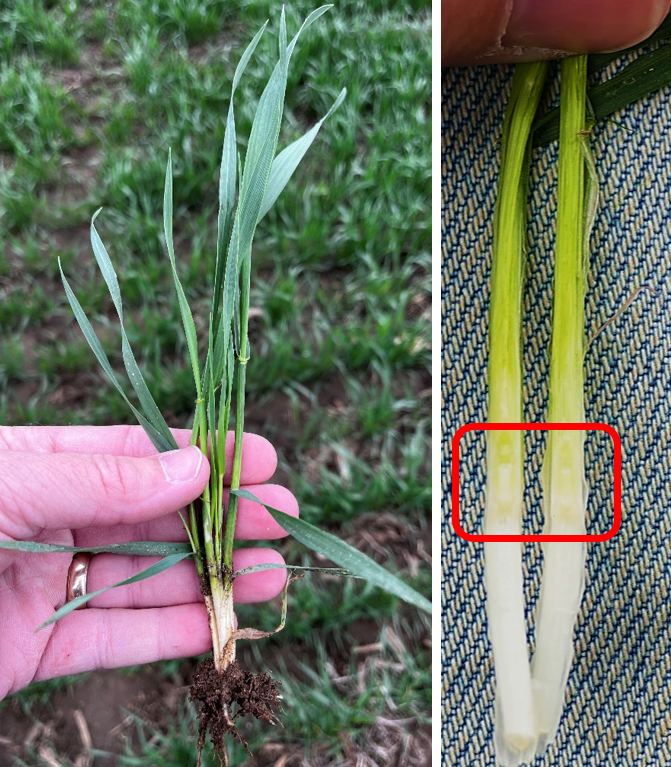
Moth trap counts this past week saw an uptick as predicted with the strong southerly winds. While counts are still in the single digits per trap in Michigan, Purdue University’s trapping network recorded black cutworm numbers in the teens in northwest Indiana (LaPorte, Indiana, and Lake, Indiana) and 31 near Fort Wayne, Indiana, while true armyworm counts were in the teens at the two northern research stations for the week ending April 20. Purdue’s crop entomologist John Obermeyer gave a recent reminder about the nature of moth trapping: “Monitoring moth arrival, and numbers captured, is an inexact science. We cannot predict with certainty that high moth counts will equate to high pest damage. Instead, it is best to understand the pest and how the next few weeks unfold. Should the moth flight continue at this pace AND fields remain untouched, then you might better understand why future articles might sound as though the ‘sky (or moths) is falling’.”
|
Moth trap counts for true armyworm (A1-4) and black cutworm (B1-3) in St. Joseph and Kalamazoo counties. | |||
|---|---|---|---|
|
12-Apr |
19-Apr |
26-Apr | |
|
A1 |
3 |
1 |
3 |
|
A2 |
0 |
0 |
5 |
|
A3 |
1 |
1 |
0 |
|
A4 |
0 |
0 |
0 |
|
B1 |
0 |
1 |
4 |
|
B2 |
0 |
0 |
4 |
|
B3 |
0 |
0 |
5 |
Black cutworm moth trap catches in Indiana for the week ending April 20. Thanks to MSU Extension field crop entomologist Chris DiFonzo for slogging through Purdue’s trap counts and entering them into the Great Lakes and Maritimes Pest Monitoring Network database.
Apps for weed/plant identification
Apps for weed/plant identification was the topic of this week’s MSU Extension Field Crops Virtual Breakfast with weed diagnostician Erin Hill. It is important to know which weeds you actually have so you can understand their life cycle, which herbicides are effective against them, and the best timing for control. Although books and websites with dichotomous keys can be helpful, they require a certain prior knowledge of plant morphology and terminology. Hill has been working over the past several years with numerous plant ID apps for smartphones to see which ones are most accurate.
In 2021, Hill and the students in her Weed Science Lab course tested eight different apps to see which ones would accurately identify a range of plants including vegetative and flowering grass and broadleaf weeds, flowering ornamentals, and winter annual seedlings. The results showed a clear winner—PictureThis—although differences existed among apps in their ability to identify different types of plants. For example, even the best app correctly identified vegetative grass weeds less 50% of the time. Although they tested only the free versions of these apps, several have paid versions ranging from a one-time fee of $5 to a $30 annual subscription.
To verify whether your app is correct for a weed you are not familiar with, you can check the USDA Plants Database and the Michigan Flora website to try to confirm. You can also send pictures or plants to the MSU Plant and Pest Diagnostic lab on campus for assistance. If you have a plant ID app you think is good that they have not tested, email Dr. Hill and make a suggestion.




 Print
Print Email
Email